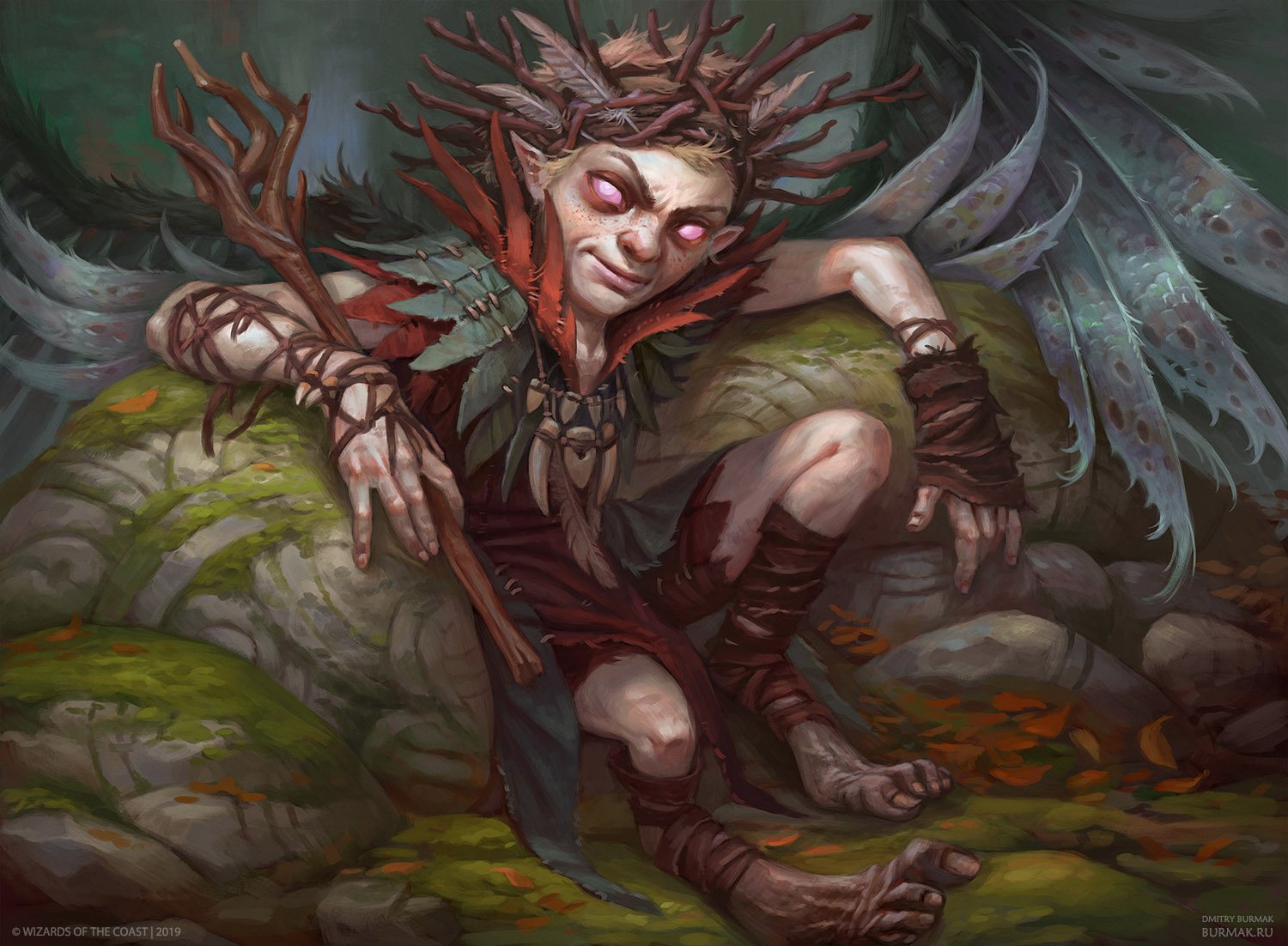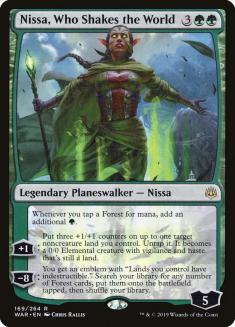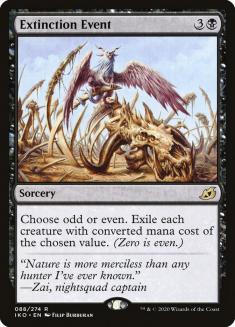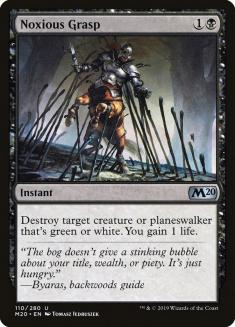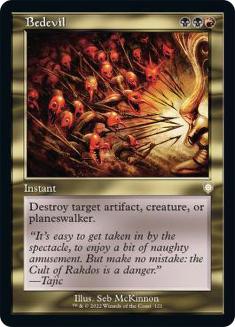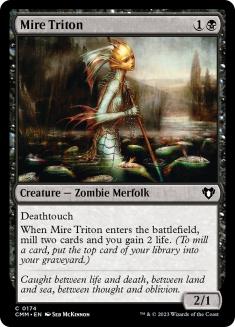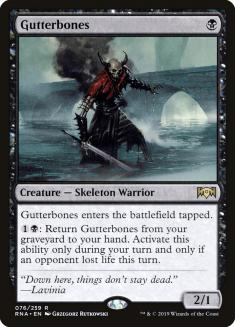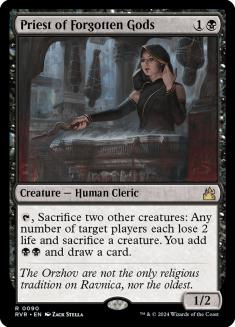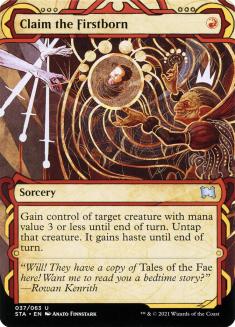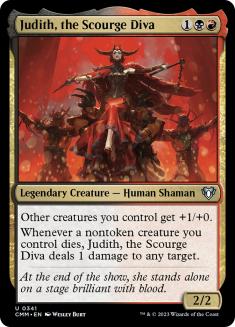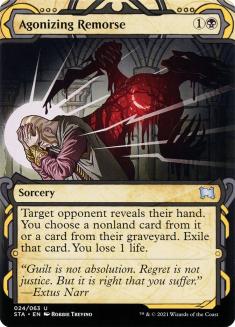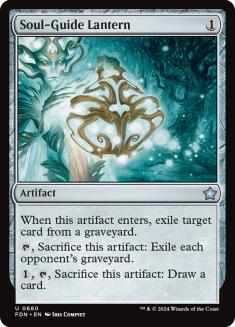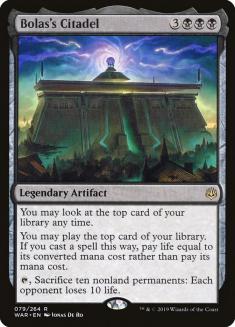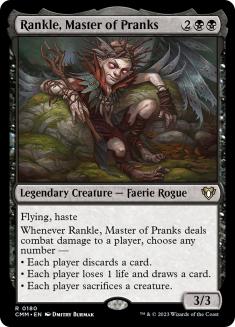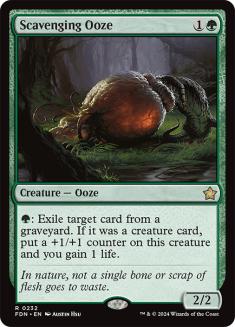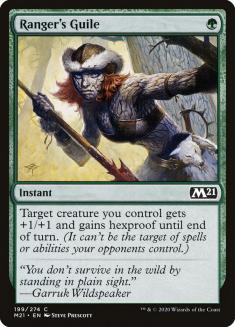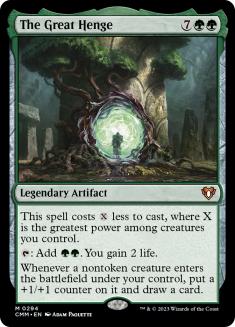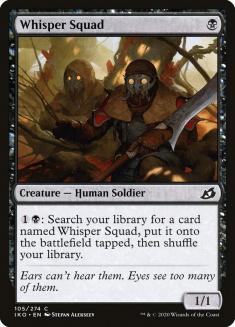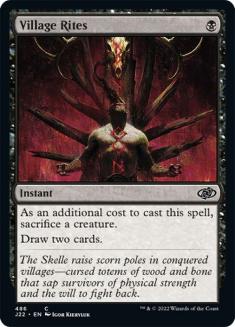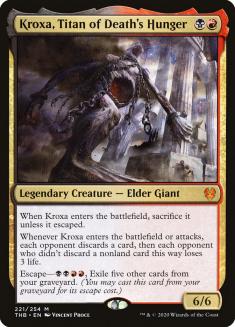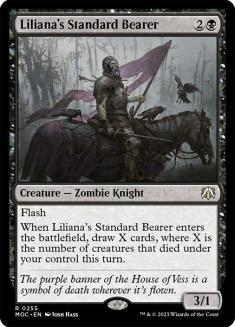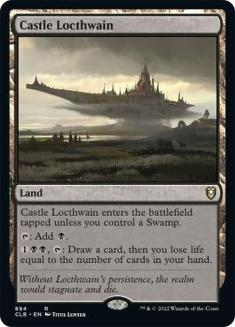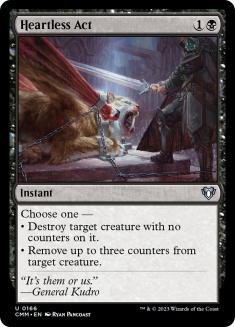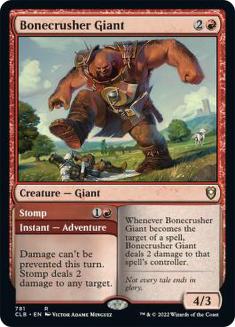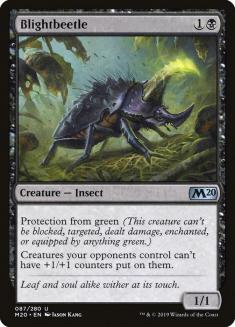Sultai Ramp continued to dominate Core Set 2021 Standard last weekend, but we are starting to see some cracks in the armor. Mono-Green Aggro took down the most recent SCG Tour Online Season Two Championship Qualifier, and Rakdos Sacrifice won the Red Bull Untapped Qualifier. Both pilots undoubtedly victimized a pile of Sultai Ramp opponents over their trophy runs and I expect to see Sultai’s metagame share start to drop as players explore options other than fighting the midrange arms race that is any Uro, Titan of Nature’s Wrath mirror.
I’ve been a proponent of Rakdos Sacrifice for two weeks now, and after back-to-back weekends with a Top 16 and a Top 4 on the SCG Tour Online, I’m confident in my list and understanding of the deck. It’s one of the trickier aggro decks I’ve played because it so rarely wins games on pure speed or with a game-ending card like Winota, Joiner of Forces or Embercleave, but that doesn’t make the deck any less powerful. It’s just that you need to be careful and use your resources purposefully. Mistakes are punishing because you don’t have cards that will completely turn a game around.
In exchange, you get an aggro deck with a low curve that nonetheless can compete in longer games because it has so much inherent card advantage. Whisper Squad; Gutterbones; Priest of Forgotten Gods; escape creatures; Village Rites; and Rankle, Master of Pranks all can generate a material advantage, and that list isn’t exhaustive. So while none of these cards will dominate a game like Uro can, they work collectively to compete on the card advantage axis.
So because the details matter, I’d like to closely examine the Sultai and Mono-Green Aggro matchups for Rakdos Sacrifice. First, here’s my updated list:
Creatures (28)
- 2 Judith, the Scourge Diva
- 4 Gutterbones
- 4 Priest of Forgotten Gods
- 3 Rankle, Master of Pranks
- 4 Woe Strider
- 3 Mire Triton
- 2 Kroxa, Titan of Death's Hunger
- 4 Whisper Squad
- 2 Liliana's Standard Bearer
Lands (20)
Spells (12)

Only minor changes from last weekend, cutting the Serrated Scorpions from the maindeck for a 24th land and a third Mire Triton while finding space for a Blightbeetle in the sideboard to help the Mono-Green Aggro matchup. Serrated Scorpion consistently underperformed as Mono-Red Aggro declined in metagame share, while Mire Triton is valuable in nearly every matchup because it trades up in combat, buffers your life against aggro decks, and can provide card advantage by milling either Gutterbones or one of your escape creatures.
Taking this list as our base, let’s look at the finer points of the two most popular matchups in the format, starting with Sultai Ramp.
Navigating the Squeeze
I mentioned this in my article last week, but it’s so important a dynamic to the matchup that it bears repeating: the most difficult part of this matchup is balancing the need to extend to the battlefield so you can effectively attack a potential Nissa with the need to hold back so you don’t lose too much material to an Extinction Event. My rule of thumb is that I’m okay losing two cards to an Extinction Event, and a third creature can easily be added if I have a Village Rites to recoup the extra card lost.
Note that when using this rule, you should take into account the creatures they may lose as well. If you’re losing two creatures but they are losing a Hydroid Krasis or Shark token, then it’s not as bad. You can also count any number of Whisper Squads found from previous Squads as negligible, since they didn’t cost you a card.
If you have enough pressure to answer a Nissa immediately while following that guideline, then you’re set. If not, then you have to make a judgment call.
The end-game starts when Uro goes unanswered.
When making this judgment call, there are two variables to consider. First is the risk-reward equation. If the added pressure puts you in a commanding position if they don’t have an Extinction Event, then it may be worth the risk. Similarly, if you have a significant battlefield that contains both even- and odd-costed creatures, then extending an extra card isn’t as risky because you’ll still have a battlefield to keep pressure. Sweepers are great when they gain card advantage, but the underrated benefit they provide is the tempo swing of answering significantly more mana worth of cards then they cost while forcing the opponent to rebuild their battlefield from scratch. If the Extinction Event is only answering half your battlefield, it’s much less scary.
On the other side of the equation, you have to consider the danger of Nissa. It’s rare that you can effectively attack it down over multiple turns because it creates a steady stream of blockers itself as well as a huge mana advantage, so your opponent is likely to deploy multiple cards on their next turn, all in service of protecting the powerful planeswalker. Instead you should be trying hard to kill it in one attack.
This is why I also try to hold my Noxious Grasps and Bedevils for as long as possible. Having a direct answer to Nissa allows you much more flexibility in playing around Extinction Event and other removal.
The second variable in this judgment call comes from your read on their hand. It’s very important that you carefully consider how they are playing the game and make an educated guess on what they are holding. In general Extinction Event is easier to get a read on, since Nissa often comes down as early as possible. You should get suspicious when your opponent doesn’t interact with you on the early turns since that’s a tell-tale sign of a sweeper. If they are aggressively trading with spot removal, then it’s more likely that they are setting up a threat like Nissa.
Unfortunately, outside of guidelines like this, reading your opponent based on their plays is highly contextual. It’s a skill you have to actively cultivate when testing. Honestly, the most important thing is to always be mindful. Always ask yourself why your opponent is playing the way they are, especially when they make a strange play.
Be Mindful of the Uro Clock
The other major dynamic comes from the best card in Standard, Uro. Simply put, Uro will take over the game eventually; your goal is to end the game before it does. There are only so many times you can kill the Titan before you run out of answers, and it always comes back. Ideally you’d be overloaded on exile effects but Epic Downfall doesn’t answer any of their other threats and Agonizing Remorse and Soul-Guide Lantern don’t answer it on the battlefield.
But because you do have a good amount of interaction and enough card advantage to play through their disruption, their late-game dominance doesn’t mean you have to be blindly aggressive. The end-game starts when Uro goes unanswered. As long as you can keep Uro in check, you can keep playing your game, pacing your threats and slowly bleeding away their life total. This is also true of Nissa to an extent, though with Uro it’s more serious because the lifegain it provides makes it hard for you to dial the pressure to eleven and hope to steal a game where you’ve fallen far behind.
Once you see that a threat is going to go unanswered, now you have to pivot into straight-up aggression. You’re going to fall too far behind on card advantage expending resources to attack down a Nissa or trade multiple creatures for an Uro. Just do your best to pressure their life total and hope for some fortunate draws. Rankle, Master of Pranks and Claim the Firstborn are your MVPs in these scenarios.
Sideboarding
With the above list, this is how I would sideboard against a stock Sultai list:
Out:
In:
Judith comes out because it’s much less effective against decks with lots of removal, while Mire Triton, while good, is still one of the lowest-impact threats in the deck. Its strength comes from how well-rounded it is, making it a solid maindeck card, but you shouldn’t be afraid to cut it when you have better options in your sideboard. The last three cuts should be the most contentious.
Priest of Forgotten Gods isn’t great in the matchup because they keep your battlefield in check and don’t have many creatures that it can answer, but I’ve gotten to the point where I always leave in two or three copies because it’s one of the best cards in the deck, and in combination with Woe Strider, Whisper Squad, and Gutterbones it can absolutely dominate a game, even against a removal-heavy strategy. If your opponent’s list is completely devoid of Hydroid Krasis, however, I’d go down to two copies.
Claim the Firstborn is another high-ceiling, low-floor card in this matchup. Sometimes it’s your best card, but it can rot in your hand for a while as you wait for a window for it to be effective. And if you flood on them early, you’re going to struggle to play through their disruption. At that point, Claim as a defensive removal spell isn’t particularly effective.
Lastly, Gutterbones is a solid card but has high diminishing returns since it’s hard to return multiples until much later into the game. I play four copies because it’s so good with Priest, but in any matchup where you’re not relying on Priest, the fourth copy becomes expendable.
As for adjusting from this plan when your opponent is on a different list, the major question is whether or not you want Heartless Act. Most lists are playing Shark Typhoon, where Act is valuable, but that’s not enough to bring the card in. You can’t bring in too much disruption of your own because you won’t have enough pressure to end the game, and eventually Uro will outlast you.
Uro will take over the game eventually; your goal is to end the game before it does.
Where I look to bring in Heartless Act is against the dedicated Flash-style Sultai lists that play not only Typhoon but Nightpack Ambusher, which also can run away with a game. These lists are usually light on Hydroid Krasis or eschew it altogether, so you can safely cut a second copy each of Priest of Forgotten Gods and Claim the Firstborn to make space without sacrificing much in the way of pressure.
I like Rakdos’s side in this matchup, but the games are close and you need to play tight to consistently come out on top. Never assume you’re going to have an easy game, and don’t relax until the concession comes.
Now let’s consider the Mono-Green Aggro matchup.
You Are the Control Deck
Role assessment is particularly important in aggro mirrors, since one deck likely has to take a more defensive role than it is used to, and in this case that deck in Rakdos. Mono-Green Aggro is severely lacking in card advantage, but their creatures hit harder and dominate combat. They also have plenty of reach from haste creatures like Questing Beast, Primal Might acting as a Fireball, and various trample effects.
So step one from the Rakdos side is to protect your life total. Trade creatures early and often with the knowledge that you will eventually take over by drawing a bunch of extra cards. At worst you’ll force them to use what little removal they have instead of developing their battlefield. The worst thing you can do is let them curve out on the first three or four turns and then untap with a piece of interaction to cement their advantage.
Step two is to figure out how you’re going to take over the game and work towards it. The most common ways you take over are with a Priest of Forgotten Gods or Rankle, Master of Pranks. With Priest, you’ll want to prioritize getting enough fodder for it, in particular Gutterbones, which keeps coming back and is an easy sink for the mana Priest adds. You’ll also want to get weak creatures like Heart’s Desire tokens or small Stonecoil Serpents off the battlefield so each Priest activation has a significant impact.
Rankle operates similarly, but with it you’ll also want to keep their reach creatures off the battlefield so it connects reliably. Often I try to set up Rankle and Claim the Firstborn on Turn 5 as the turning point in the game, since that sequence can answer two big threats at once and start to pressure their life total.
Once you’ve established control of the battlefield, the game devolves into methodically closing each and every window of opportunity they have to steal a win. Sometimes you leave back a blocker for Questing Beast, leave back two blockers so you don’t lose to Primal Might, or cling to a key removal spell for Scavenging Ooze or a big Stonecoil Serpent. You won’t always be able to close every window, but you absolutely want to minimize their chances of topdecking because they are surprisingly good at it for an aggro deck because many of their threats scale well later in the game.
Avoid Blowouts
Without reliable sources of card advantage, Mono-Green Aggro relies on individual card power to compete in games where its early aggression is stymied. In the case of Rakdos Aggro, the cards to watch out for are Scavenging Ooze, Ranger’s Guile, and The Great Henge.
Scavenging Ooze is their best card in the matchup, and dodges much of your removal after sideboarding. Prioritize escaping when you can so you don’t lose the opportunity to do it and make sure you exile dead creatures to those escapes to limit its growth potential. You should also avoid relying on your escape creatures as reliable sources of card advantage. They can take over a game if your opponent doesn’t have an Ooze, but if you count on it you could find yourself in major trouble when the Ooze comes down.
When it comes to Ranger’s Guile, it’s about not getting cute. Just kill their creature on your main phase if they are tapped out. They rely on curving out, so if it’s in their hand, they have to telegraph it to leave up the mana. If they want to play that way, let them waste that mana for as long as you can and try to set up a multiple-removal-spell turn to limit the tempo gain from their trick.
Fortunately, playing against The Great Henge is the same as Ranger’s Guile. Kill their creatures on your turn. Henge can dominate a game if it enters the battlefield early, but if you trade aggressively and kill their bigger creatures with removal, it’s hard for them to cast it with any gas back to start drawing cards, so you’ll have a small window to win before it snowballs out of control.
Sideboarding
Out:
In:
Sideboarding in this matchup is rather straightforward. You bring in removal and the silver bullet Blightbeetle and cut some of your slower sources of card advantage. Village Rites is at its worst when your opponents play very little removal and you’re utilizing Priest as often as possible. I’ve also started trimming a Whisper Squad since you rarely have the time or desire to find every copy and it’s not something you want to cast and activate early.
Kroxa is the most surprising cut, and one that I’ve only recently started to make, because the body is excellent in the matchup. But casting the front half is a huge liability early and it’s very difficult to escape in the face of Scavenging Ooze. Even if the Ooze doesn’t exile Kroxa specifically, whatever cards it does hit will limit the food for the Titan.
The spot removal helps you a lot. In Game 1 you’re light on interaction outside of Claim the Firstborn and rely heavily on an early Priest to contain their battlefield, but after sideboarding you get to function more easily as a control deck, only you gain your card advantage with creatures.
When the SCG Tour Online started, I had been out of practice in Standard, and it showed. I played a few decks to little success and wasn’t comfortable playing haymaker-centric ramp mirror matches. It’s a little late in the game, but I’ve now found a powerful deck whose strategy I’m comfortable with and I’m looking forward to closing this Standard season out strong.
This last weekend showed that the format is more than just Sultai Ramp, so I expect more late-game metagame shifts than you typically see. But for now, these are the two most important matchups for Rakdos Sacrifice, and mastering them is essential for tournament success.

